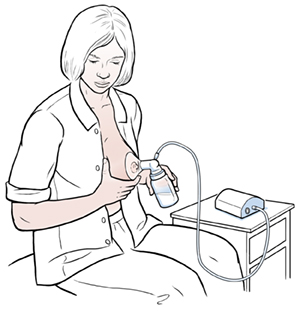Expressing Milk for Your High-Risk Baby
Expressing your milk
You will have to remove milk from your breasts on a regular basis to provide enough
of your milk for your high-risk baby. Many mothers find they can appreciate their
babies' breastfeeding patterns when they understand how milk is produced. Initially,
hormones play an important role in the production of milk. After the first 1 to 2
weeks after the baby is born, milk removal, through either breastfeeding or milk expression,
has a greater effect on the amount of milk produced.
How is milk produced?
With the delivery of the placenta after a baby's birth, a drop in the hormones that
maintained the pregnancy soon occurs. This allows the hormone prolactin to begin to
work. The placenta had been producing hormones that maintained the pregnancy. The
sudden drop in these hormones, once the placenta is gone, signals prolactin to start
working. Prolactin "tells" the breasts it is time to start making large amounts of
milk. A mother feels the result of prolactin when her milk "comes in" about 3 to 5
days after birth. Increased milk production usually occurs at this time. This happens
even if a baby has not been breastfeeding well or often. However, frequent breastfeeding
or milk expression sometimes speeds up the process of establishing increased milk
production. Occasionally, a mother has a delay in the production of large amounts
of milk.
Successful milk production
Ongoing, long-term milk production depends mostly on milk removal by nursing or pumping.
The more often milk is removed, and the more completely it is removed, the more milk
the breasts make. The opposite is also true. When milk is removed less often, or not
enough is removed, the breasts get the signal to slow milk production and make less.
Milk removal occurs when a baby effectively breastfeeds. Or you are pumping frequently
to keep your breasts drained.
Breastfeeding needs effective sucking by the baby so that enough milk is transferred
from the breast into the baby's mouth where it is swallowed. To suck, a baby must
latch deeply onto the breast and use the structures in their mouth to create intermittent
suction and squeeze milk into their mouth. Proper sucking signals the mother's body
to release the hormone oxytocin. With the release of oxytocin, your milk will "let
down." This is the term used to describe the flow of milk from the breasts.
So if your baby is premature or sick and unable to remove milk effectively enough
to stimulate and maintain your milk production, you will need to express milk until
they are stronger.
Milk expression methods

Milk transfer also can be done through milk expression methods. This can be done with
your hand or with a breast pump. Hand expression is done by compressing the breast
tissue with your hand. Your milk can then be collected onto a spoon or into a container.
There are breast pumps that can remove the milk as well. Some breast pumps are manually
operated, while others are either battery-powered or electric. "Hands-on pumping"
is a method combining breast massage and pumping, which helps maximize milk supply
in mothers of premature infants.